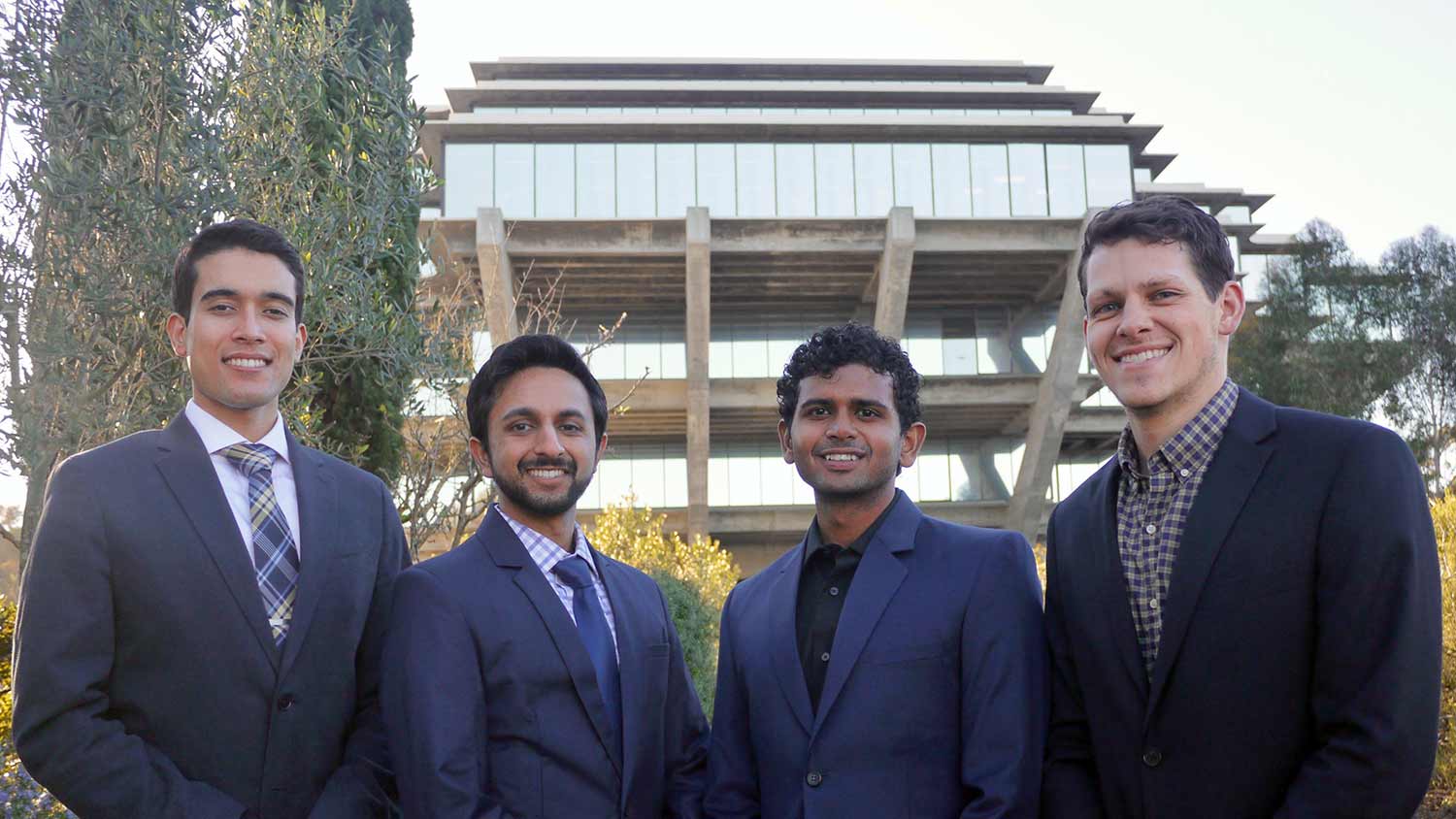
By:
- Deborah L. Jude
Published Date
By:
- Deborah L. Jude
Share This:

Blue LINC cofounders. From left to right: Kevin Jubbal (president), Gaurav Agrawal (vice president), Vish Ramesh (director of external affairs) and Nick Forsch (director of internal affairs).
The Missing Link: UC San Diego’s First Biomedical Incubator
An engineer watching a cardiac surgeon open up a patient’s chest to treat the heart may plan to build a better way to help the surgeon open the chest. However, if the engineer instead explores alternate means to access the key structures, the surgeon may not need to open up the chest at all. This anecdote illustrates the importance of determining the right need to solve.
This kind of problem solving is one of the goals of a new biomedical incubator at UC San Diego, called Blue LINC. The new program is entirely student-run.
Incubators are organizations that assist emerging businesses in developing business and marketing plans, building teams, obtaining capital and accessing other professional services. University-affiliated incubators have gained traction due to resources like faculty mentorship, integrated research and development processes, and access to specialized facilities and equipment.
When Kevin Jubbal arrived at UC San Diego as a medical student, he immediately noticed that an incubator specific to health care and medical technology innovation was missing from the entrepreneurial ecosystem at UC San Diego.
“The university plays host to a number of entrepreneurial programs, but none focused on solving problems in the clinic,” said Jubbal.
Jubbal set out to create an incubator modeled after the Stanford BioDesign Program, a successful biomedical incubator that teaches a repeatable process on how to innovate. He reached out to friends at the Rady School of Management and the Jacobs School of Engineering for help getting the project off the ground, one of which was Gaurav Agrawal, a graduate student in bioengineering.
Agrawal had already completed the NSF-funded I-Corps program through the Jacobs School’s von Liebig Center for Entrepreneurism – a path-to-market program based on the Lean LaunchPad Startup Methodology. His team of bioengineering graduate students developed a technological platform to address the limitations associated with current pre-clinical pharmaceutical drug testing processes.
“During the customer discovery phase of the I-Corps program, we learned that it is critical to address the correct need that is required by the customer to have a value proposition,” said Agrawal. “In the I-Corps program, you enter with a technology and must find the need that it addresses. Blue LINC is the opposite; we want teams to find the clinical needs and then develop a technology to solve this. Practicing physicians are regularly exposed to clinical problems, but often lack the time or resources to address them. On the other hand, graduate students may possess the resources but lack the exposure to understand clinical problems. Blue LINC will help bridge this gap.”
At the beginning of the Blue LINC program, students will form multidisciplinary teams consisting of at least one medical, one business and one engineering student. The teams will spend two weeks observing clinical practices and identifying needs before selecting a problem to tackle.
From there, the innovation phase begins. Solutions are subjected to competitive analysis, feasibility analysis and customer validation.
During the final phase, students will learn about how to implement their solutions in hospitals, clinics or the biotechnology marketplace.
“Our program is unique because it incorporates every phase from ideation to commercialization,” said Jubbal. “The commercialization phase is extremely important because a solution won’t make an impact unless it reaches the patients, and it won’t reach the patients if it doesn’t do well in the market.”
The program, which also includes design reviews by faculty and lectures taught by an alumnus of UC San Diego and of Stanford’s Biodesign program, will conclude with a Demo Day to investors, physicians and industry representatives in June 2017, where teams will hope to garner seed funding to formally spin out.
All UC San Diego students are welcome to apply following the pilot program. If you are a clinician and have a problem you’d like to submit, or would like to be a clinical advisor, please visit bluelincsd.com.
Blue LINC is funded by the University of California Office of the President as part of the Innovation and Entrepreneurship Initiative.
Share This:
You May Also Like
Stay in the Know
Keep up with all the latest from UC San Diego. Subscribe to the newsletter today.


